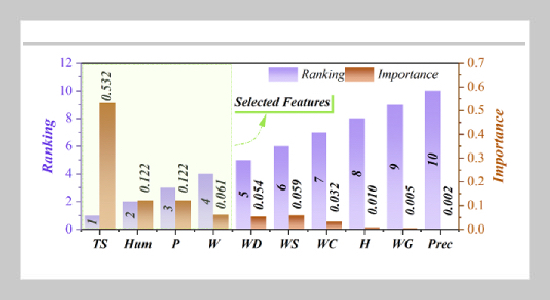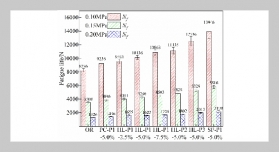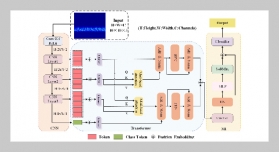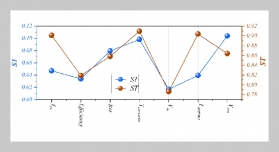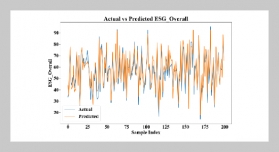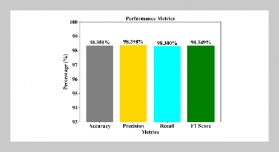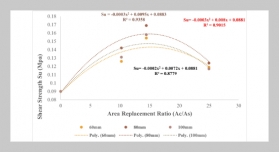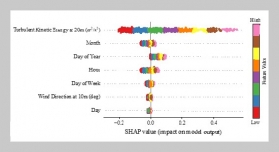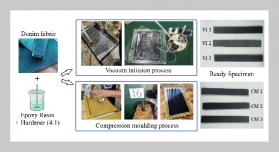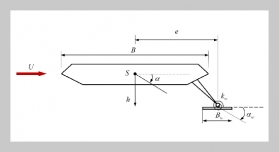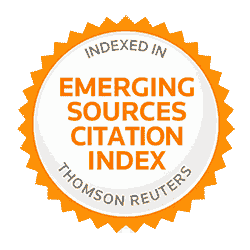- [1] A. Moussavi-Khalkhali, M. Jamshidi, and L. B. E. Chair. “Leveraging machine learning algorithms to perform online and offline highway traffic flow pre dictions”. In: 2014 13th International Conference on Ma chine Learning and Applications. IEEE, 2014, 419–423. DOI: https: //doi.org/10.1109/ICMLA.2014.75.
- [2] C.-Y. Li, G.-M. Xu, and T.-Q. Tang, (2018) “Social optimum for evening commute in a single-entry traffic corridor with no early departures" Physica A: Statistical Mechanics and Its Applications 502: 236–247. DOI: https: //doi.org/10.1016/j.physa.2018.02.098.
- [3] H. Gao, J.-y. Zhao, and L. Jia, (2008) “Summary of short-time traffic flow forecasting methods" JOURNAL JINANUNIVERSITYSCIENCEANDTECHNOL OGYEDITION22:88.
- [4] A. D. Doulamis, N. D. Doulamis, and S. D. Kollias, (2003) “An adaptable neural-network model for recursive nonlinear traffic prediction and modeling of MPEG video sources" IEEE Transactions on Neural Networks 14: 150–166. DOI: https: //doi.org/10.1109/TNN.2002.806645.
- [5] I. Okutani and Y. J. Stephanedes, (1984) “Dynamic prediction of traffic volume through Kalman filtering theory" Transportation Research Part B: Methodological 18: 1–11. DOI: https: //doi.org/10.1016/0191-2615(84)90002-X.
- [6] Y. Qi and S. Ishak, (2014) “A Hidden Markov Model for short term prediction of traffic conditions on freeways" Transportation Research Part C: Emerging Technologies 43: 95–111. DOI: https: //doi.org/10.1016/j.trc.2014.02.007.
- [7] H. Liu, X. Zhang, and X. Zhang, (2018) “Exploring dynamic evolution and fluctuation characteristics of air traffic flow volume time series: A single waypoint case" Physica A: Statistical Mechanics and its Applications 503: 560–571. DOI: https: //doi.org/10.1016/j.physa.2018.02.030.
- [8] S. Gowrishankar, (2008) “A time series modeling and prediction of wireless network traffic" Computer Sciences and Telecommunications: 40–52.
- [9] M. S. Ahmed and A. R.Cook. Analysis of freeway traffic time-series data by using Box-Jenkins techniques. 1979.
- [10] M.V. D. Voort, M. Dougherty, and S. Watson, (1996) “Combining Kohonen maps with ARIMA time series models to forecast traffic flow" Transportation Research Part C: Emerging Technologies 4: 307–318. DOI: https: //doi.org/10.1016/S0968-090X(97)82903-8.
- [11] T.-Q. Tang, T. Wang, L. Chen, and H.-Y. Shang, (2017) “Impacts of energy consumption and emissions on the trip cost without late arrival at the equilibrium state" Physica A: Statistical Mechanics and its Applications 479: 341–349. DOI: https: //doi.org/10.1016/j.physa.2017.03.019.
- [12] J. Zhang, T.-Q. Tang, and S.-W. Yu, (2018) “An improved car-following model accounting for the preceding car’s taillight" Physica A: Statistical Mechanics and its Applications 492: 1831–1837. DOI: https://doi. org/10.1016/j.physa.2017.11.100.
- [13] W.-X. Zhu and H. M.Zhang, (2018) “Analysis of feed back control scheme on discrete car-following system" Physica A: Statistical Mechanics and its Applications 503: 322–330. DOI: https: //doi.org/10.1016/j.physa.2018.02.192.
- [14] G. Peng, H. Kuang, and L. Qing, (2018) “A new lattice model of traffic flow considering driver’s anticipation effect of the traffic interruption probability" Physica A: Statis tical Mechanics and Its Applications 507: 374–380. DOI: https: //doi.org/10.1016/j.physa.2018.05.095.
- [15] P. C. Vythoulkas and P. B. Goodwin, (1993) “Very Short Term Traffic Forecasting for the Control of Dynamic Driver Information Systems" TSU REF 741:
- [16] W. ZHENGandQ.X.Shi,(2005) “Study of short-term freeway traffic flow prediction based on Bayesian combined model" China Journal of Highway and Transport 18: 85–89.
- [17] Q. Hou, J. Leng, G. Ma, W. Liu, and Y. Cheng, (2019) “Anadaptivehybrid model for short-term urban traffic flow prediction" Physica A: Statistical Mechanics and its Applications 527: 121065. DOI: https: //doi.org/10.1016/j.physa.2019.121065.
- [18] C.N.BabuandB.E.Reddy,(2014)“Amoving-average filter based hybrid ARIMA–ANN model for forecasting time series data" Applied Soft Computing 23: 27–38. DOI: https: //doi.org/10.1016/j.asoc.2014.05.028.
- [19] I. Okutani and Y. J. Stephanedes, (1984) “Dynamic prediction of traffic volume through Kalman filtering theory" Transportation Research Part B: Methodological 18: 1–11. DOI: https: //doi.org/10.1016/0191-2615(84)90002-X.
- [20] X. Jiang and H. Adeli, (2005) “Dynamic wavelet neural network model for traffic flow forecasting" Journal of transportation engineering 131: 771–779. DOI: https: //doi.org/10.1061/(ASCE)0733-947X(2005)131:10(771).
- [21] W. Zheng, D.-H. Lee, and Q. Shi, (2006) “Short-term freeway traffic flow prediction: Bayesian combined neural network approach" Journal of transportation engineering 132: 114–121. DOI: https: //doi.org/10.1061/(ASCE)0733-947X(2006)132:2(114).
- [22] X. Ma, Z. Tao, Y. Wang, H. Yu, and Y. Wang, (2015) “Long short-term memory neural network for traffic speed prediction using remote microwave sensor data" Transportation Research Part C: Emerging Technologies 54: 187–197. DOI: https: //doi.org/10.1016/j.trc.2015.03.014.
- [23] L. Prokhorenkova, G. Gusev, A. Vorobev, A. V. Doro gush, and A. Gulin, (2018) “CatBoost: unbiased boosting with categorical features" Advances in neural in formation processing systems 31:
- [24] A. V. Dorogush, V. Ershov, and A. Gulin, (2018) “Cat Boost: gradient boosting with categorical features sup port" arXiv preprint arXiv:1810.11363: DOI: https: //doi.org/10.48550/arXiv.1810.11363.
- [25] N. Bakhareva, A. Shukhman, A. Matveev, P. Polezhaev, Y. Ushakov, and L. Legashev. “Attack de tection in enterprise networks by machine learning methods”. In: 2019 international Russian automation conference (RusAutoCon). IEEE, 2019, 1–6. DOI: https: //doi.org/10.1109/RUSAUTOCON.2019.8867696.
- [26] Y. Xia, L. He, Y. Li, N. Liu, and Y. Ding, (2020) “Predicting loan default in peer-to-peer lending using narrative data" Journal of Forecasting 39: 260–280. DOI: https: //doi.org/10.1002/for.2625.
- [27] L. Diao, D. Niu, Z. Zang, and C. Chen. “Short-term weather forecast based on wavelet denoising and catboost”. In: 2019 Chinese control conference (CCC). IEEE, 2019, 3760–3764. DOI: https: //doi.org/10.23919/ChiCC.2019.8865324.
- [28] J. Fan, X. Wang, F. Zhang, X. Ma, and L. Wu, (2020) “Predicting daily diffuse horizontal solar radiation in various climatic regions of China using support vector ma chine and tree-based soft computing models with local and extrinsic climatic data" Journal of Cleaner Production 248: 119264. DOI: https: //doi.org/10.1016/j.jclepro.2019.119264.
- [29] J. P. M. Overman, H. J. L. Witte, and J. G. Saldarriaga, (1994) “Evaluation of regression models for above-ground biomass determination in Amazon rainforest" Journal of tropical Ecology 10: 207–218. DOI: https: //doi.org/10.1017/S0266467400007859.
- [30] C. R. Sanquetta, A. P. D. Corte, A. Behling, L. R. de Oliveira Piva, S. P. Netto, A. L. Rodrigues, and M. N. I. Sanquetta, (2018) “Selection criteria for linear regression models to estimate individual tree biomasses in the Atlantic Rain Forest, Brazil" Carbon balance and management 13: 25. DOI: https: //doi.org/10.1186/s13021-018-0112-6.
- [31] I. Fayad, N. Baghdadi, J.-S. Bailly, N. Barbier, V. Gond, B. Hérault, M. E. Hajj, F. Fabre, and J. Per rin, (2016) “Regional scale rain-forest height mapping using regression-kriging of spaceborne and airborne LiDAR data: Application on French Guiana" Remote Sensing 8: 240. DOI: https: //doi.org/10.3390/rs8030240.
- [32] R. VaRjabedian, (2010) “Atlantic rainforest law: environmental regression" estudosavançados 24: 147 160. DOI: https: //doi.org/10.1590/S010340142010000100013.
- [33] Y. Yahya, R. Ismail, S. Vanna, and K. Saret. “Using data mining techniques for predicting individual tree mortality in tropical rain forest: logistic regression and decision trees approach”. In: Proceedings of the 8th International Conference on Ubiquitous Information Management and Communication. 2014, 1–5. DOI: https: //doi.org/10.1145/2557977.2557989.
- [34] V. L. Deringer, A. P. Bartók, N. Bernstein, D. M. Wilkins, M. Ceriotti, and G. Csányi, (2021) “Gaussian process regression for materials and molecules" Chemical reviews 121: 10073–10141. DOI: https: //doi.org/10.1021/acs.chemrev.1c00022.
- [35] E. Schulz, M. Speekenbrink, and A. Krause, (2018) “A tutorial on Gaussian process regression: Modelling, exploring, and exploiting functions" Journal of mathematical psychology 85: 1–16. DOI: https: //doi.org/10.1016/j.jmp.2018.03.001.
- [36] J. Q. Shi and T. Choi. Gaussian process regression analysis for functional data. CRC press, 2011. DOI: https: //doi.org/10.1201/b11038.
- [37] K. Kim, D. Lee, and I. Essa. “Gaussian process re gression flow for analysis of motion trajectories”. In: 2011 International Conference on Computer Vision. IEEE, 2011, 1164–1171. DOI: https: //doi.org/10.1109/ICCV.2011.6126365.
- [38] L. Wang, Q. Cao, Z. Zhang, S. Mirjalili, and W. Zhao, (2022) “Artificial rabbits optimization: A new bio-inspired meta-heuristic algorithm for solving engineering optimization problems" Engineering Applications of Artificial Intelligence 114: 105082. DOI: https: //doi.org/10.1016/j.engappai.2022.105082.
- [39] R. M. Rizk-Allah, S. Ekinci, and D. Izci, (2023) “An improved artificial rabbits optimization for accurate and efficient infinite impulse response system identification" Decision Analytics Journal 9: 100355. DOI: https: //doi.org/10.1016/j.dajour.2023.100355.
- [40] Q. N. Huu, L. N. Ngoc, T. B. Tien, H. T. Ngoc, H. N. Tran, and T. N. Xuan, (2024) “An improved Artificial Rabbit Optimization for structural damage identification" Latin American Journal of Solids and Structures 21: e523. DOI: https: //doi.org/10.1590/1679-78257810.
- [41] D. Izci, R. M. Rizk-Allah, V. Snášel, S. Ekinci, F. A. Hashim, and L. Abualigah, (2023) “A novel control scheme for automatic voltage regulator using novel modified artificial rabbits optimizer" e-Prime-Advances in Electrical Engineering, Electronics and Energy 6: 100325. DOI: https: //doi.org/10.1016/j.prime.2023.100325.
- [42] Anshtanwar. fic Volume Metro Dataset. Interstate Available Traf at: https://www.kaggle.com/datasets/anshtanwar/metrointerstate-traffic-volume/data.2023.


